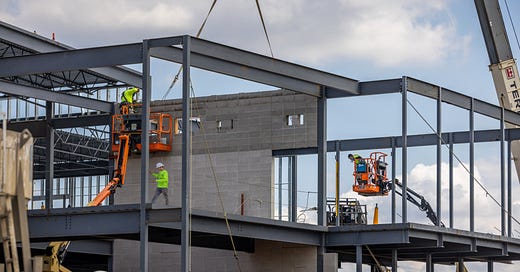Many high-growth cities see slowing number of new residents
Local leaders say demand remains high — and so does the pressure to keep up with infrastructure needs

South Dakota’s fastest growing city saw another jump in people moving to its expanding borders – once again leading the state in population growth, according to the latest U.S. Census Bureau estimates.
But the growth in Harrisburg didn’t hit the double-digit figures that it had hit in the previous three years. The 8.35 percent from July 1, 2023 to July 1, 2024 was about 3 percentage points lower than two of the previous three years.
That’s a trend followed by many of the state’s other fastest growing communities. Tea, for example, which had registered double-digit growth in 2021 and 2022 saw a 4.6 percent increase in 2024, down from 6.4 percent in 2023. Box Elder saw almost no new growth from 2023 to 2024 after seeing a 10.3 percent increase the year before. Deadwood went from 8.1 percent in 2023 to no new growth last year.
That’s according to The Dakota Scout’s analysis of Census Bureau data on cities with 1,000 or more residents.
Some cities bucked the trend. Spearfish, for example, increased by 3.7 percent, up from 3 percent a year earlier. The city has grown by 13 percent over the last four years.
Statewide, the population of South Dakota grew by 4 percent from 2020 to 2024, from 886,729 to 924,669. The majority of that increase occurred from migration to the highest growing cities.
Rapid growth in some communities in East and West River taxed local resources as cities struggled to keep up with the demands of new roads, sewers and roads. But local officials who spoke to The Dakota Scout say that a cool down hasn’t given them time to take a breath.
“We’re still playing defense and trying to keep up with infrastructure as far as roads go,” said Harrisburg Mayor Derick Wenck.
They also think some of the slowdown could be temporary, triggered by inflation rates that skyrocketed in 2023 and 2024, prompting higher interest rates. The proximity of communities like Tea, Harrisburg and Hartford to the state’s largest city also has officials thinking that growth will continue, even if it’s at a slower pace.
“We’ve kind of tried to ride the big brother’s coattails as much as we could,” said Tea City Administrator Justin Weiland. Tea now shares a border with Sioux Falls, Weiland noted, and the two entities are participating in development on 85th Street and Interstate 29. Sioux Falls also treats some of Tea’s wastewater.
Some cities have taken action to keep the growth going. In Deadwood, officials noticed the slowdown and realized that many of the new homes sold in the last couple of years were for short-term rentals, or second homes, said Mayor Charlie Struble-Mook. That suppressed the number of available homes for people who wanted to buy one and become a Deadwood resident.
So, the city took action to limit them.
“Hopefully, that will show an increase in population if they can be used as long-term homes,” Struble-Mook said.
Room to grow
Struble-Mook, who has been on the Deadwood City Commission since 2017, said the city has room to expand its boundaries, should it be necessary to annex additional land. That hasn’t happened in her years on the commission.
Although development in downtown Deadwood is strictly regulated to meet the gambling town’s historic standards, the city has room for new developments within its existing boundaries, she added. In the meantime, Deadwood officials are planning for more water, police and fire protection.
“They definitely see that and see that it’s a hurdle we need to cross,” she said.
Tea’s existing developable lots have dwindled, and officials are starting to look at the next tier of growth, Weiland said. Although Tea has bumped up against Sioux Falls at 85th Street, there is still room to annex land to the northwest and south, although sewer line expansion poses challenges to an extent.
“We’ve got the ability to grow, but it’s a certain type of development,” he said of Tea’s existing borders.
Harrisburg annexed 300 acres a few years ago and just annexed another 300 acres, Wenck said. But when interest rates rose, making loans more expensive for homebuyers, single-family starter home sales fell off. But that hasn’t been the case for buyers of high-end homes who seem to be less sensitive to interest rate hikes. One development with high-end homes has seen steady sales.
“Those are homes from $600,000 to $2 million,” Wenck said.
On the starter level, developers are building more townhomes and apartments in Harrisburg.
“They’re filling those up as fast as they can build them,” he said.





















Help me understand why there is a race to expand the city, increase its population, and build more of everything?
It's very temporary. Here's the US population projection for the next 75 years based on different immigration scenarios that explodes Republican's heads.
https://www.brookings.edu/interactive/figure-1-projected-annual-us-population-size-2022-2100/?r=1748841&b=1
Reducing immigration leads to wage inflation, fewer customers, lower tax bases.